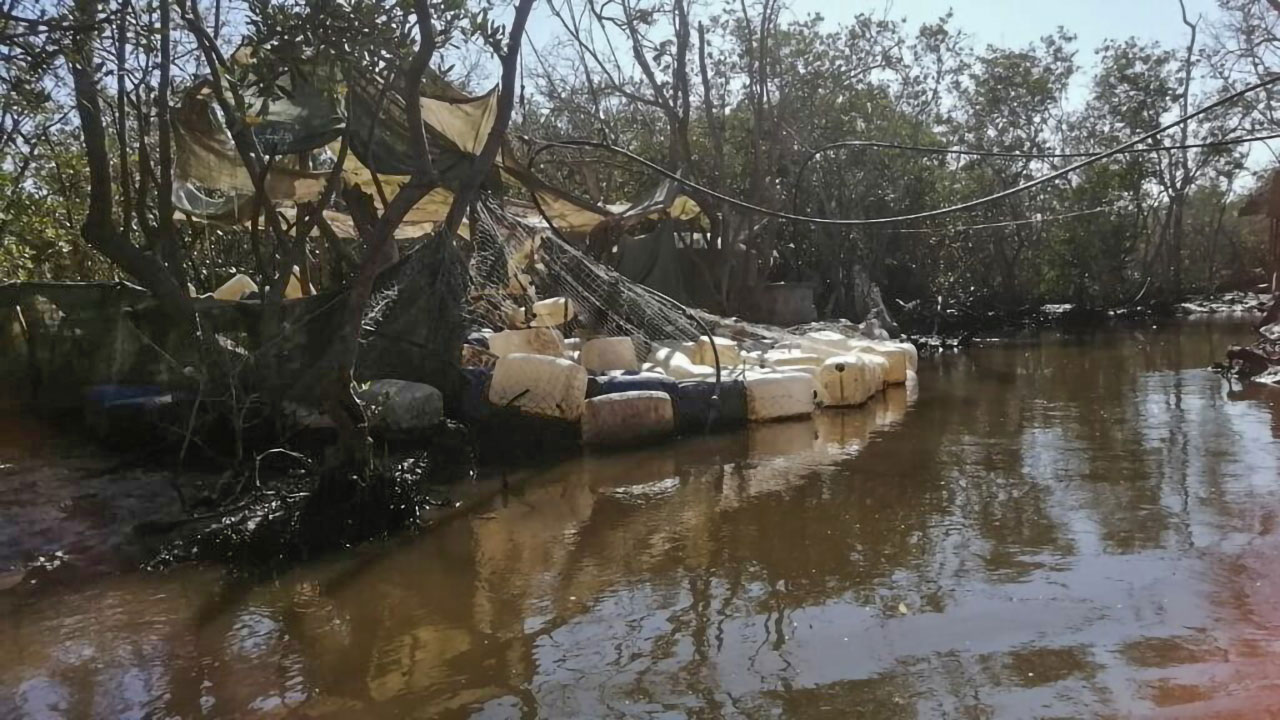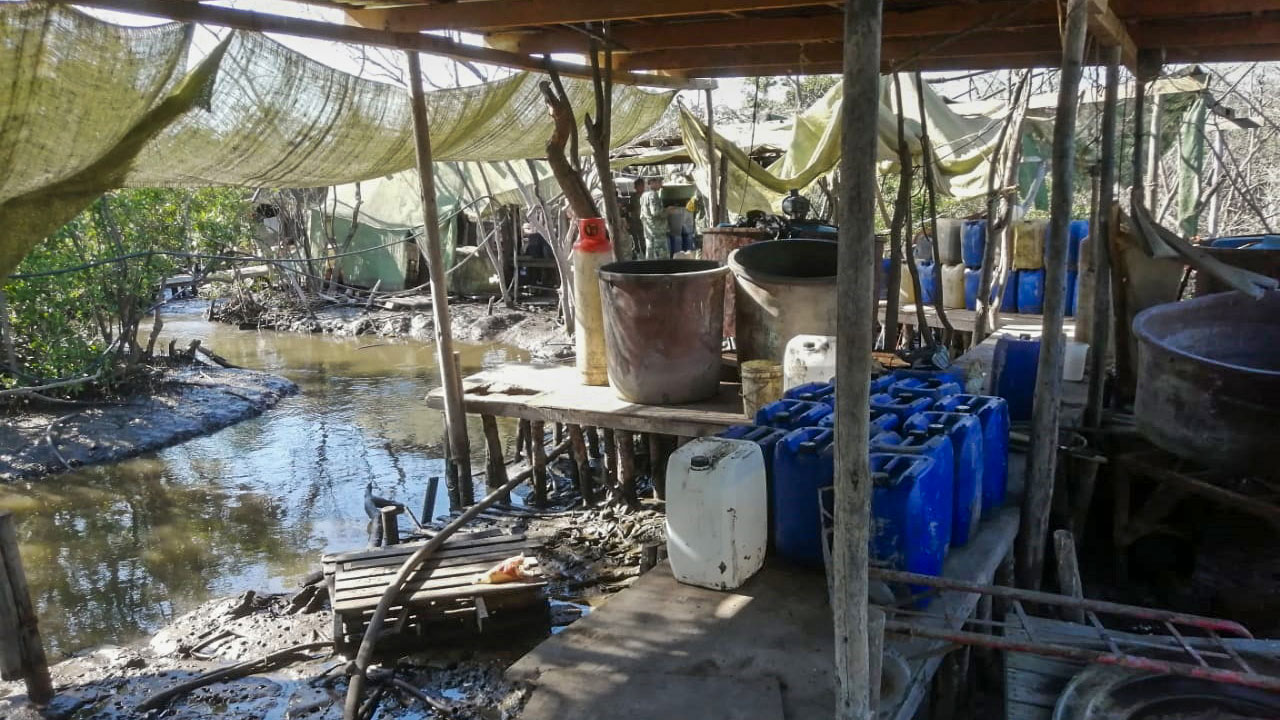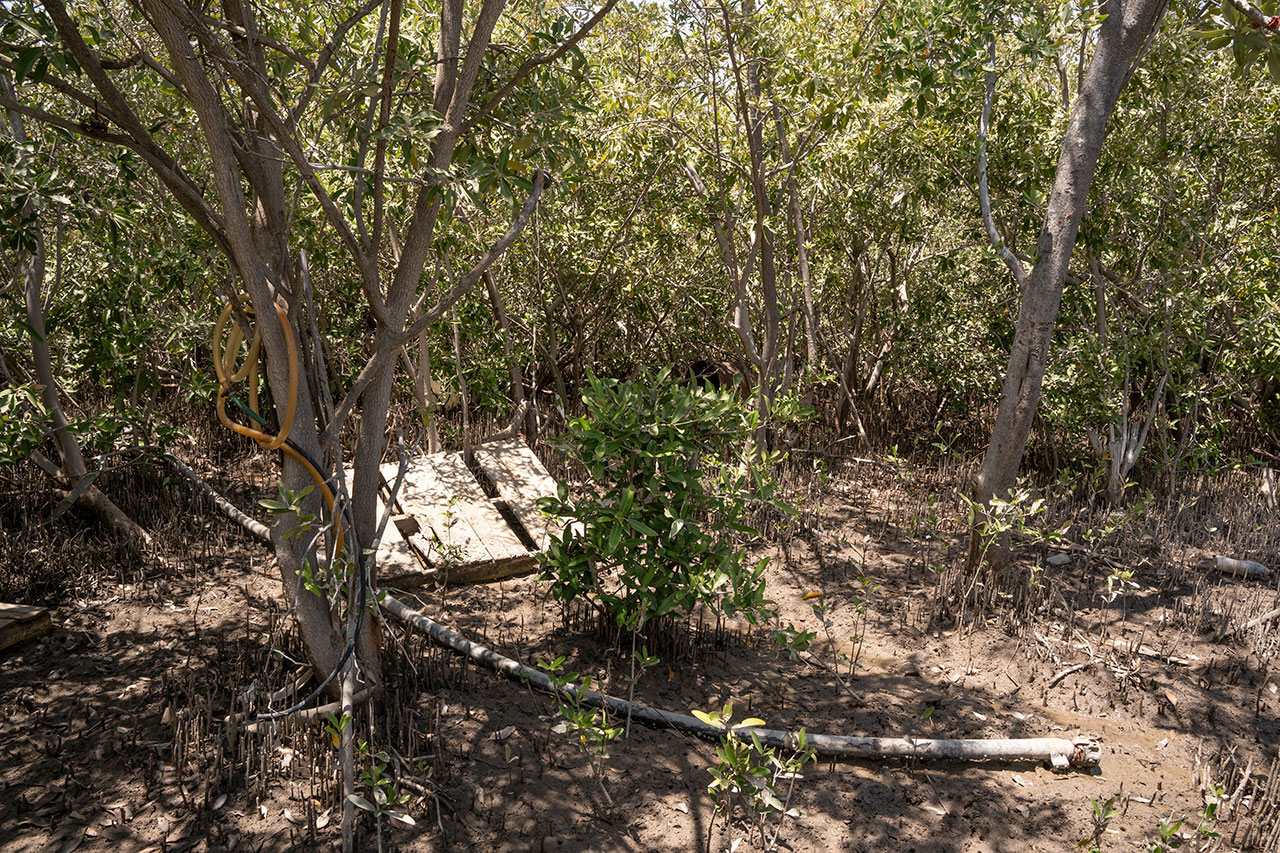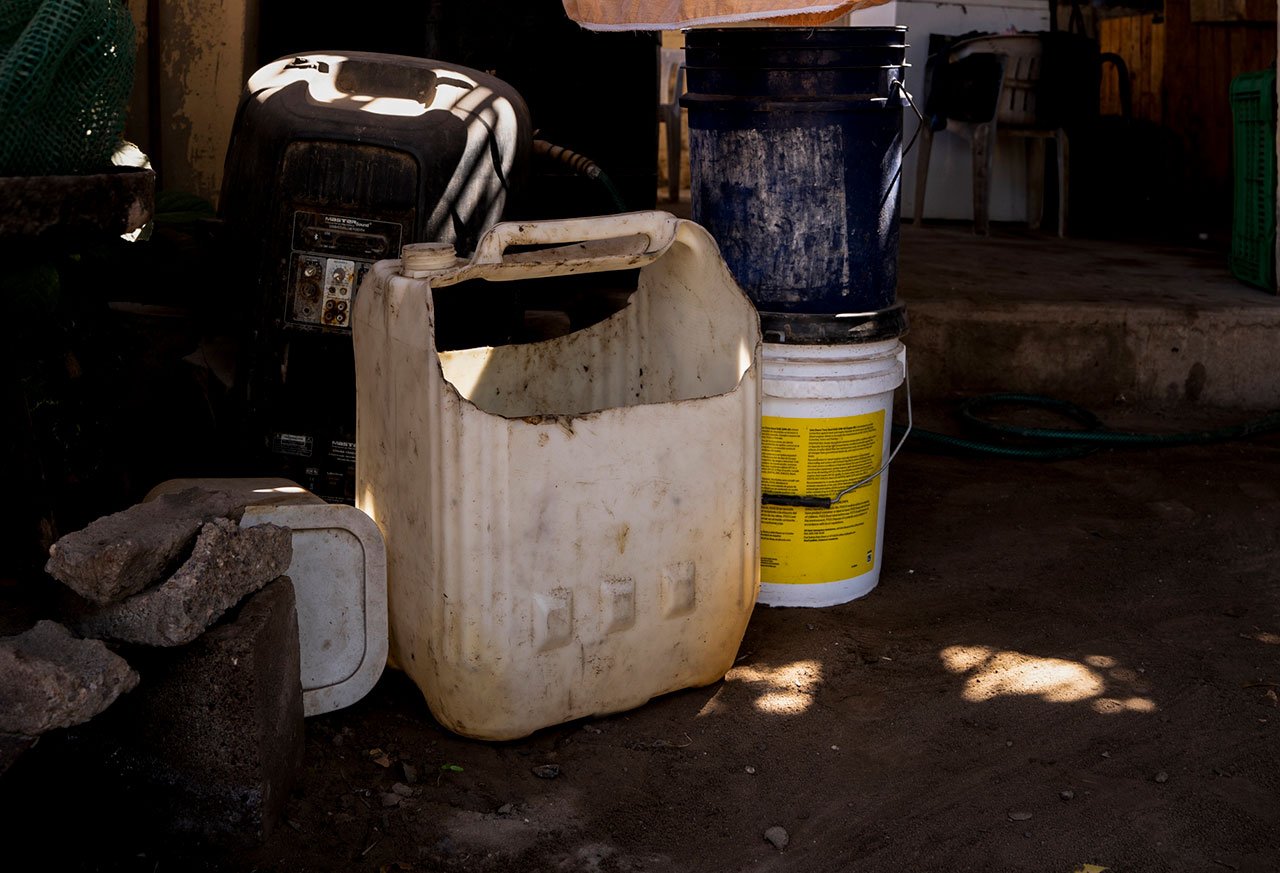
Organized crime in Mexico has found the mangroves an ideal, remote spot to hide their synthetic drug laboratories, leaving fishermen in Sinaloa to deal with contamination affecting their homes and livelihoods.
We traveled just over an hour from a fishing camp in Navolato, in central Sinaloa, to the clandestine laboratory, maneuvering our skiff through a canal that local fishermen call "El Pericón". Not just anyone can navigate here. Besides the narrow spots, there are shallow depths where a boat can run aground.
It requires skill and experience, not a problem for our guide, who took us through the mangroves to the spot where a methamphetamine lab was dismantled in October 2021.
Along the way, our guide tells us that they fish for red snapper, corvina, grouper, mullet, and some snook in this region; they also harvest oysters and mangrove tree crab. The narco-lab intruded on a high-production zone.
As we took one of the narrower channels, we were hit by strong chemical odors coming from the mangroves. It was nearly two years since the lab was dismantled, but the smell persisted, something rotten and artificial. The odor was strong even for our guide.
For the local fishermen, mangroves are a natural refuge for fish, a place where they’re protected from predators and allowed to grow. Crustaceans also breed in their roots.
But now they serve as a different kind of refuge, a preferred space for cartels to install synthetic drug laboratories because of the difficult access. Security forces won’t easily find the labs, and local residents are not likely to report them.
"They hit the jackpot," said Leonardo Moroyoqui Rojo, a scholar at the National Autonomous University of Mexico and an expert in coastal ecosystems. "It’s very difficult to find them there, unless the government comes in with advanced technology and starts using drones. But in the mangroves, it’s very difficult for them to locate you."
What’s at Stake?
For our guide, along with his family and most of those who live on the edge of the wetlands, fishing means survival. Navigating the areas of Navolato, mangrove roots filled with oysters and fish jumping in the water show why protecting nature is so important for them.
There are 42,654 registered fishermen in Mexico, according to the National Registry of Fishing and Aquaculture, the vast majority of whom work the coasts, like our guide.
Mexico produced 1.9 million tons of seafood, including 237,250 tons of farmed products in 2023, according to the Ministry of Agriculture and Rural Development. Sinaloa ranks No. 2 among Mexican states in overall seafood production, and first in production of farmed products.
In 2020, Sinaloa had 76,300 hectares of mangroves, according to the Mangrove Monitoring System in Mexico, the highest figure in the North Pacific region. Moroyoqui Rojo, through his own study, estimates an annual loss of around 800 kilograms of shrimp and fish per hectare of destroyed mangrove.
Esteban García Peña, director of Fisheries at Oceana in Mexico, said mangroves also serve as a protective barrier against meteorological phenomena such as hurricanes, and losing them means losing significant reservoirs of greenhouse gas.
"If there’s mangrove loss, there are no shelters for reproduction, and if you add the presence of chemical precursors and substances whose effects we don’t know, that’s another thing we have to investigate,” he said.
Shortly after detecting the chemical smell, we began to see the first drums, or "tambulacas" as the owner of the boat called them. They were nestled among the roots of the mangroves, just a few meters from the water. There were also steel tanks and larger containers up to a thousand liters; some still had liquid inside. The steel doesn’t concern the locals like the objects of thick plastic that are destined to float.
In the midst of the mangrove is a barren area, near the laboratory site, where sprouts of vegetation try to push through the boats, hoses and debris left behind.
We spotted a clearing, where drug traffickers had cut down the mangroves to make room for the reactors that produced methamphetamine. There were still many containers that authorities left behind _ a tank with yellowish liquid inside, burners, the mesh they used to conceal the laboratory and the pallets they walked on to avoid sinking into the marshy ground.
Before it was seized, the laboratory had been operational for years. The fishermen know because members of organized crime barred them from fishing in the waters. Now that the lab is gone, they still choose not to fish there because of the contamination.

Containers used to store chemical precursors floating in the mangrove swamp in Navolato, Sinaloa. Photo: Sinaloa’s Ministry of Public Security

The remnants of a synthetic drug laboratory discovered in the middle of the mangroves in Navolato, Sinaloa. Photo: Sinaloa’s Ministry of Public Security
Where the mangrove was razed, the soil is stained, possibly from chemicals. Our guide said he doesn’t know what kind of chemicals were spilled. But he saw the red soil and wondered what might spread when the tide rises.
After surveying the area and taking pictures, we quickly left at the request of our guide. With the surrounding mangroves as cover, he said, you could never know who could be watching.
Failures of Authority
Sinaloa state police first discovered the laboratory when, patrolling with the military, they noticed a strong chemical smell.
Days later, on October 28, 2021, the federal Attorney General’s Office reported the seizure of 2,409 liters of hydrochloric acid, 1,189 liters of phenyl-2-propanone, 160,999 grams of chemicals, and 129 liters of sodium hydroxide. They confiscated 709 liters of methamphetamine, 554 liters of benzyl cyanide, 289 liters of toluene, and 29 liters of acetone, along with gas tanks, pots, a shredder, and centrifuges.
The lab was only accessible by boat, prohibiting authorities from removing much of the laboratory debris.

Hoses, drums, pallets and other debris are left behind by the authorities dismantling drug labs and become part of the mangroves. Photo: Luis Gerardo Magaña.
Mexico has regulations for handling, storing, disposing and transporting chemical substances, but nothing that specifically pertains to precursors used in illegal drug labs.
The Ministry of Environment and Natural Resources (Semarnat for its initials in Spanish) is in charge of restoring ecosystems such as mangroves, according to federal law. Quinto Elemento Lab, through a public information request, asked how many of its cases involved illegal drug labs. The answer was zero.
The Federal Prosecutor for Environmental Protection (Profepa for its initials in Spanish), investigates and sanctions environmental damage in collaboration with the states, as well as deciding who is responsible for the cleanup or restoration.
According to Profepa records, the prosecutor’s office received 27,330 complaints from 2018 to 2022. Sixty-five percent were verified, but only 1,608 resulted in criminal complaints, most related to illegal logging and forestry issues. As with Semarnat, not a single case involved an illegal synthetic drug lab.
There is limited information on the impact of illegal drugs labs on the environment because the research has just started, according to the U.N. Office on Drugs and Crime 2022 World Drug Report. While there is a well-studied link between drugs and deforestation, the report focuses mainly on the production of cannabis, coca, and opium plants.
The U.N. does note that manufacturing synthetic drugs can produce large amounts of dumping. For example one kilogram of methamphetamine can produce at least 6 kilograms of waste. It also said that aquatic organisms, such as bacteria, algae, invertebrates and fish, “have receptors that can make them sensitive to controlled drugs entering the ecosystem.”
“Concentrations of methamphetamine were found to affect the health of fish,” it added.
Danger from More Labs
Locals and environmentalists know that the site we visited is not the only lab among the mangroves, talking about at least two other locations in the coastal area.
In 2023, Sinaloa state security officials said there were four more irregular sites among the mangroves where "apparently methamphetamine was being produced." In the same year, the navy launched a massive operation to search for laboratories and floating precursors in the coastal area. They reported the area they covered but not what they found.
Moroyoqui Rojo estimates that it could take up to 25 years to completely clean up the pollution caused by these laboratories. He added that because of his work, he has traveled along the Sinaloa coast and, along with colleagues, encountered armed men in the marshes.
Ximena, an activist who only gave her first name for security reasons, said her environmental group had their hovercraft stolen at the beginning of the pandemic. They used it for bird monitoring in low-water areas. She believes it may have been stolen by lab operators, possibly for quick escapes.
The Coastal People
Gliding through the water, we saw 200-liter containers float by, as the tides have brought lab debris closer to active fishing areas. Our guide tells us he collects them and uses them at home to store oysters or liquids. He says he’s not the only one. Others, too, talk about reusing the containers that once stored chemical precursors.
Some carried labels like cyanide, hydroxide, and acetone, the guide says. Others had stranger names that he no longer remembers. He doesn’t know what any of these chemicals are, but knows that if they burned the mangroves and stained the land, they can’t be good.
He avoids using containers that still “smell bad.”

Local residents salvage containers that once held chemicals for the production of methamphetamine and reuse them in their homes in Navolato, Sinaloa. Photo: Luis Gerardo Magaña
The fisherman also has salvaged hoses from the reactors to use as rubber protectors to keep the mangroves from breaking his fiberglass boat _ but only if he finds them floating in the water. He and most locals still prefer not to get too close to the lab sites.
He says it’s too bad that no authority has come to clean up. And he worries that over time, the sun will damage the floating plastic containers, causing leaks and spills that will end up in the roots of the mangroves or be carried away by the current.
Our guide shakes his head as we return to the fishing grounds; he had preferred to avoid that place, which everyone knows and talks about because of the environmental damage.
Local and federal authorities say the lab has been secured and dismantled. What they don’t say is that dozens of containers, some with liquids, were left among the mangroves, along with other contaminated materials now in the fishing areas, on the boats, and in the backyards where children play.